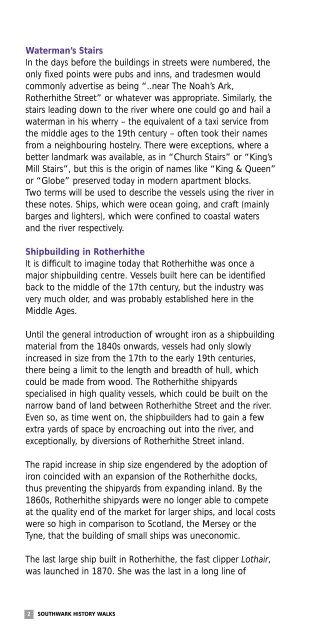Granaries, Shipyards and Wharves - Cycling from Guildford
Granaries, Shipyards and Wharves - Cycling from Guildford
Granaries, Shipyards and Wharves - Cycling from Guildford
Create successful ePaper yourself
Turn your PDF publications into a flip-book with our unique Google optimized e-Paper software.
Waterman’s Stairs<br />
In the days before the buildings in streets were numbered, the<br />
only fixed points were pubs <strong>and</strong> inns, <strong>and</strong> tradesmen would<br />
commonly advertise as being “..near The Noah’s Ark,<br />
Rotherhithe Street” or whatever was appropriate. Similarly, the<br />
stairs leading down to the river where one could go <strong>and</strong> hail a<br />
waterman in his wherry – the equivalent of a taxi service <strong>from</strong><br />
the middle ages to the 19th century – often took their names<br />
<strong>from</strong> a neighbouring hostelry. There were exceptions, where a<br />
better l<strong>and</strong>mark was available, as in “Church Stairs” or “King’s<br />
Mill Stairs”, but this is the origin of names like “King & Queen”<br />
or “Globe” preserved today in modern apartment blocks.<br />
Two terms will be used to describe the vessels using the river in<br />
these notes. Ships, which were ocean going, <strong>and</strong> craft (mainly<br />
barges <strong>and</strong> lighters), which were confined to coastal waters<br />
<strong>and</strong> the river respectively.<br />
Shipbuilding in Rotherhithe<br />
It is difficult to imagine today that Rotherhithe was once a<br />
major shipbuilding centre. Vessels built here can be identified<br />
back to the middle of the 17th century, but the industry was<br />
very much older, <strong>and</strong> was probably established here in the<br />
Middle Ages.<br />
Until the general introduction of wrought iron as a shipbuilding<br />
material <strong>from</strong> the 1840s onwards, vessels had only slowly<br />
increased in size <strong>from</strong> the 17th to the early 19th centuries,<br />
there being a limit to the length <strong>and</strong> breadth of hull, which<br />
could be made <strong>from</strong> wood. The Rotherhithe shipyards<br />
specialised in high quality vessels, which could be built on the<br />
narrow b<strong>and</strong> of l<strong>and</strong> between Rotherhithe Street <strong>and</strong> the river.<br />
Even so, as time went on, the shipbuilders had to gain a few<br />
extra yards of space by encroaching out into the river, <strong>and</strong><br />
exceptionally, by diversions of Rotherhithe Street inl<strong>and</strong>.<br />
The rapid increase in ship size engendered by the adoption of<br />
iron coincided with an expansion of the Rotherhithe docks,<br />
thus preventing the shipyards <strong>from</strong> exp<strong>and</strong>ing inl<strong>and</strong>. By the<br />
1860s, Rotherhithe shipyards were no longer able to compete<br />
at the quality end of the market for larger ships, <strong>and</strong> local costs<br />
were so high in comparison to Scotl<strong>and</strong>, the Mersey or the<br />
Tyne, that the building of small ships was uneconomic.<br />
The last large ship built in Rotherhithe, the fast clipper Lothair,<br />
was launched in 1870. She was the last in a long line of<br />
2 SOUTHWARK HISTORY WALKS


